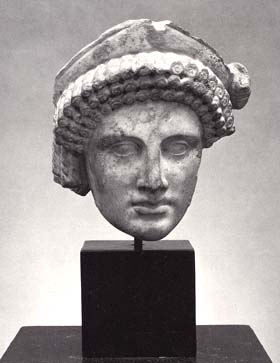
Unknown
Roman
Archaistic Female Head, 1st c. BCE. late
marble
9 1/2 in.
SBMA, Gift of Wright S. Ludington
1973.72
POSTSCRIPT
Previously labeled Head of a Goddess, perhaps Aphrodite, Greco-Roman, with the date listed as probably first century CE probably from Asia Minor.
COMMENTS
The eclectic combination of stylistic elements which constitutes this head is characteristic of the late Hellenistic period - the last two centuries before Christ. The artist began with a severe version of a fourth century BCE facial type and added to it an archaistic hairstyle of corkscrew curls and a third century Hellenistic diadem.
The particular facial type with its dreamy gaze, small curved mouth and cleft between lower lip and chin was invented in the fourth century BCE by Praxiteles. In the early third century it reached a peak of popularity when Arsinoe II, wife of Ptolemy II Piladelphos and queen of Egypt from 275-270 BCE personified the type and made herself much beloved. Deified after her death, statues of Arsinoe were erected in Olympia, Athens and in every votive temple in Egypt, often as the incarnation of Aphrodite or Isis. The strong line of nose and forehead in the Santa Barbara head is too stylized to belong to a portrait, but the influence of the Arsinoe type is still clear.
The head has two further points of interest. It is capped by the tettix, a rare Hellenistic coiffure of tightly corkscrewed curls, deliberately intended to recall sixth century prototypes. The tettix is known chiefly from terracottas and a few heads from the coastal cities of Asia Minor. It first appeared c. 200 BCE in modest form, very much as it is in this piece. By the first century BCE however, women were exaggerating the archaistic style into a high crown of curls. The head is also adorned by a stephane (crescent-shaped diadem ). One of two projecting knots of hair survives, caught up behind the circlet. The diadem originally represented the crown of Venus and other goddesses in the Classical period, but in Hellenistic times it was adopted by women who aspired to rival the deities. The first example of human usage appeared on coins of Arsinoe II, probably representing the queen as Aphrodite. Within a century the diadem appeared regularly on terracottas of anonymous women - good sociological evidence of their increased importance in late antiquity.
The late Hellenistic period is notable for its artistic eclecticism. The Classical, Archaic and Hellenistic styles were combined and recombined in architecture and sculpture. The traditional religion of the Greeks was almost overwhelmed by the onslaught of new cosmopolitan ideas, the atheistic criticism of philosophy, and the competition of the newly imported mystery cults. Over the centuries the temples had accumulated votive offerings which cluttered the precincts--often visited by artists and the educated as "museums." Works like the Santa Barbara head were undoubtedly commissioned as an attempt to revive the awe which had once surrounded the Olympian gods. Like all attempts to revive the dead past, it failed, but numerous stylistically-curious works like the Santa Barbara head witness the long-standing human effort to avert change.
- Sandra E. Knudsen ,SBMA Art Historian, writing on recent acquisitions in 1973
SBMA CURATORIAL LABELS
This female head was most likely the top of a herm in its original state. Herms were sacred boundary markers comprised of an upright shaft of stone crowned by a sculpted head, commonly found at road-crossings or in the vicinity of important buildings like temples. lt is termed “Archaistic” because it employs formal characteristics of earlier Greek art from the 7"‘ through the 4"‘ centuries BCE.
- Greco-Roman, 2022
This female head almost certainly derives from a herm, a sacred boundary stone that took the form of an upright shaft crowned by a sculpted head (the earliest herms carried the head of the Greek god Hermes). It is a curious pastiche of Greek styles, combining the stylized snail-curl hair of the archaic period with facial features characteristic of classical and hellenistic sculpture. An archaic (or archaistic) style is often found in herms and other traditional religious sculpture. Classical and hellenistic aspects are less common, and they identify this head with the philhellenic classicism of the early Roman empire.
- Thayer Gallery, 2002
